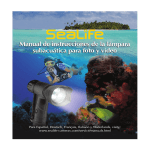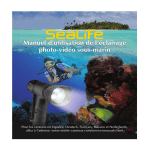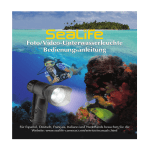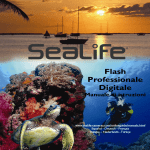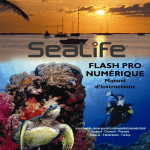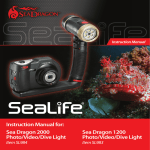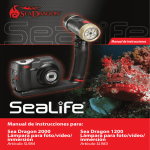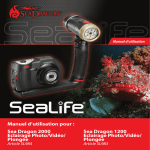Download Sealife SL980 Troubleshooting guide
Transcript
Contents: I. Safety Warnings...........................................................3 II. Check What You Got ...................................................4 III. Product view with call-outs.........................................5 IV. Loading batteries .........................................................6 V. Operating the light ......................................................7 VI. Maintaining a waterproof seal (Before your dive) ........8 VII. Care and maintenance (After your dive) ......................9 VIII. Replacing the O-rings................................................10 IX. Attaching light to underwater camera........................11 X. Recommended Camera Settings ...........................12-13 XI. Great pictures made easy.....................................14-17 XII. Advanced Settings................................................18-19 XIII. Troubleshooting Guide..............................................20 XIV. Specifications ...........................................................21 XV. Parts and Service .......................................................22 www.sealife-cameras.com/service/manuals.html Español - Deutsch - Français - Italiano - Nederlands 2 I. Safety Warnings Avoid using light above water for prolonged periods of time. The light is designed for underwater use to help displace heat. Turn light off if any parts of the light become hot to the touch. If water has entered the light, immediately turn off power and discontinue use. Remove batteries and allow the inside to dry. Contact the SeaLife service center for repairs. Use new or freshly-charged AA batteries. Do not mix old and new batteries together. Remove batteries from light before transporting, traveling or long periods of storage. Do not expose light to heat or direct sunlight for prolonged periods of time. Observe all SCUBA dive safety rules and control your buoyancy at all times. Consult your dive instructor for dive safety questions. Visit www.sealife-cameras.com for updates to this manual and underwater photography tips 3 II. Check What You Got Spare O-rings SL9806 Light (with arm, base and coiled lanyard) Smaller Mounting Screw SL96025 O-ring Lube SL9807 (for mounting camera) Longer Mounting Screw SL96022 (for mounting camera plus flash) O-ring remover SL9808 4 III. Product view with call-outs SeaLife Underwater Photo-Video Light (item # SL980) Major parts 1 – Battery Cap 2 – Mode Button 3 – Coiled Lanyard 4 – Release Button 5 – Pressure Safety Relief Valve 6 – Flexible Arm 7 – Mounting Base (Tray) 8 – Threaded Mounting screw Hole (Screw not shown) 5 IV. Loading batteries 1) Unscrew the battery cap 2) Remove the battery holder 3) Insert 4 new or freshly charged AA batteries into holder. 4) Make sure each battery is installed correctly according to the polarity markings on the battery holder. 5) Make sure O-ring and sealing surfaces are perfectly clean and undamaged. 6) Screw on battery cap (hand tighten – don’t use tools) 6 V. Operating the light 1) Push and hold the mode button for 1 second to power ON the light. 2) Push the mode button to change between the following light modes: 100% ➜ 50% ➜ 25% ➜ Blinking ➜ SOS ➜ 100%........ 3) Push and hold the mode button for 2 seconds to power OFF the light. 7 VI. Maintaining a waterproof seal (Before your dive) 1) The light uses two O-rings to maintain a waterproof seal. 2) Every time you open the battery cap make sure the O-rings and sealing surfaces are clean, undamaged and lubricated. 3) Dampen a clean cotton cloth and wipe it around the o-ring and o-ring contact surfaces to remove any hair, sand or debris. 4) Carefully inspect the o-ring for cuts, tears or other damage. Replace o-rings immediately if damaged. 5) Lube O-rings if dry. Apply a small amount of silicone lube on your finger tip and wipe it around the O-rings. Wipe off excess lubricant. The o-ring should appear wet. 1 – O-rings 2 – O-ring contact surface Important: Replace O-rings every year if damaged or not. Visit your local SeaLife dealer or www.sealife-cameras.com for information on ordering spare o-rings. 8 VII. Care and maintenance (After your dive) 1) After each dive, soak the sealed light in fresh water for about 15 minutes to remove any residual salt, sand and dirt. Never allow the saltwater to dry on the light. 2) Push the mode button about 10 times to clean any saltwater or sand trapped under the button. 3) Let the water drain out of the two small holes located at the bottom of flexible arm (under the tray) 4) Dry off the light with a towel. Make sure you and the light are dry before opening the waterproof battery cap. 5) Remove batteries before storing the light. 6) Allow light to thoroughly dry before storage. 7) Never use any detergents, cleaners, solvents or chemicals to clean the light. 8) Insert a fresh Moisture-Muncher capsule (item #SL911) inside the battery compartment during storage to help keep the inside dry and free of corrosion or mildew during storage. 9 VIII. Replacing the O-rings Replace the two O-rings if damaged or at least once per year. 1) Use the O-ring Remover tool provided to lift and remove the O-ring. 2) Carefully clean O-ring grooves and O-rings before installation 3) Install O-rings by stretching and lifting O-ring into the groove. Do not roll the O-ring or allow it to twist. 4) Apply a small amount of silicone lube on your finger tip and wipe it around the O-rings. Wipe off excess lubricant. The o-ring should appear wet. 10 IX. Attaching light to underwater camera Important: Only attach the light to cameras/housings with minimum thread depth of 0.250” and using standard 1/4-20 tripod type thread. Don’t over-tighten screw or you may damage the housing and threads. Camera and Light Camera, Light and Flash (Best results) 1) Align the underwater camera to the light’s mounting screw and hand-tighten. Use small screw provided for mounting one light. 2) To attach two lights (or a combination of one light and one SeaLife Digital Pro Flash), use longer screw (SL960220. 11 X. Recommended Camera Settings For SeaLife Camera and Light Only (Not using Digital Pro Flash): 1) Set the camera’s scene mode to Sea mode or Snorkel mode 2) Change camera’s PHOTO and VIDEO White Balance settings to CLOUDY. For SeaLife Camera, Light and Digital Pro Flash configuration: 1) Set the scene mode to Ext. Flash mode 2) Change the VIDEO White Balance setting to CLOUDY. Note: The white balance settings for Photo and Video modes function independently of each other. Set both settings to Cloudy. For other underwater camera brands: 1) Set the Scene mode to “Auto” or “Underwater” scene mode, as recommended by the camera manufacturer. 2) You may also need to change the White Balance setting to CLOUDY depending on the camera’s underwater color correction or if pictures/video turns out red. 12 Are your pictures or videos too red? GOOD: White balance set to Cloudy BAD: White balance not set to Cloudy Aiming and releasing the light The flexible flash arm is fully adjustable to allow quick and easy aiming of the light. Check the camera display to make sure the light is aimed at the subject before taking a picture. You can remove the light from the arm, by pushing the release button located on the side of the grip. Note: The flexible arm consists of seven 1-inch (2.5cm) links covered by foam rubber sleeve. You can bend the flexible arm in any direction, but if you force it beyond the point of resistance, the links will separate. If the links separate, you can reconnect it by pushing the links together until they snap in. 13 XI. Great pictures made easy There are plenty of challenges that photographers face in the underwater world. Please take some time to review SeaLife’s online guide called Great Pictures Made Easy by visiting www.sealife-cameras.com. The guide is located under the Technical Support menu. The following information summarizes the basic principles of underwater photography. Crystal clear water Clear water is essential for good underwater pictures. Low visibility, caused by fine particles suspended in the water, will diminish the picture and video quality. As a general rule, limit your shooting distance to 1/10 of the water visibility. For example, if the visibility is 20 ft, limit your shooting distance to 2 ft. Try to keep the light as far away from the camera lens as possible to minimize backscatter. 14 Limit your shooting distance Water is 800 times denser than air and quickly absorbs light. The SeaLife light has an effective range of 2 (60cm) to 3 ft (90cm) depending on visibility and battery strength. The SeaLife Digital Pro Flash (SL961) has an effective range of 6ft (1.8m) to 8ft (2.4m). If you are using the SeaLife underwater light in combination with the SeaLife flash, limit your shooting distance to 6 ft (1.8m). 4 ft (1.2m) is ideal. If you are using the SeaLife light only, limit your shooting distance to 2 ft (60cm) to 3ft depending on visibility and battery strength. Closer shooting distances result in better pictures. Consider purchasing the SeaLife Wide Angle Lens accessory, which allows you to keep a closer shooting distance and fit everything into the picture. 15 Control your buoyancy Get your buoyancy under control and set yourself up in the ideal position before taking a picture or shooting video. This allows you to hold the camera steady and control your shooting distance. Good buoyancy control will help you avoid stirring up the sandy bottom which will cloud-up the water and cause backscatter. Controlling your buoyancy is very important for your diving safety so don’t start shooting until your buoyancy is under control. Practice makes perfect There is no better way to learn than from your mistakes. Become familiar with your camera controls so you can make quick adjustments depending on the conditions. Take the time to practice and experiment with different settings. Review your pictures and learn from your mistakes. 16 Compose a good picture Avoid shooting down on the subject from above. Shooting down usually results in a poor contrast because the subject blends into the background. Try and shoot upwards from below the subject so you get a blue water background and better contrast. Get the entire subject into your picture frame. Don’t cutoff the hands, fins or head of your subject. You can always crop you image later on your computer if you want. Video tips Hold the camera as steady as possible and move (pan) very slowly. A jumpy, fast-moving video is hard for anyone to watch and can actually cause motion sickness Avoid shooting video clips more than 1 minute. It is difficult to edit a lengthy video clips because the large file size. You can always patch together short video scene into a longer movie using video editing software, like Microsoft Movie Maker. Always observe dive safety rules and Never Touch Marine Life Do not let photography distract you from diving safely. Observe marine life - Never touch marine life. Be aware of your surroundings to avoid contacting anything. Keep your dive gear close to your body. 17 XII. Advanced Settings Customized Light Modes You can select between 8 different light mode settings: • Flash Cancellation ON or OFF: When ON, the light dims for 2 seconds when detecting external flash. • Light Power Levels: Single power (100%) or 3 power (100% ➜ 50% ➜ 25%) or 3 power plus signal (100% ➜ 50% ➜ 25% ➜ Blinking ➜ SOS) • Power Overdrive: Increase light power to 600 lumens for 2 minute. To change the light mode setting, remove the battery cap and holder. On the bottom of the battery compartment you will see 3 small toggle switches. Use a pen or similar object to adjust the switches. See next page for light mode settings. 3 small toggle switches located inside the battery compartment. 18 Advanced Settings (continued) The light mode factory default setting is “H” A - Flash cancellation mode ON. 100% light power only B - Flash cancellation mode OFF. 100% light power only C - Flash cancellation mode ON. 3 light powers: 100% ➜ 50% ➜ 25% ➜ D - Flash cancellation mode OFF. 3 light powers: 100% ➜ 50% ➜ 25% ➜ E - Flash cancellation mode ON. 3 light powers and 2 signals: 100% ➜ 50% ➜ 25% ➜ Blinking ➜ SOS ➜ F - Flash cancellation mode OFF. 3 light powers and 2 signals: 100% ➜ 50% ➜ 25% ➜ Blinking ➜ SOS ➜ G - Flash cancellation mode ON. 3 light powers 100% ➜ 50% ➜ 25% ➜ . For 120% Power overdrive mode: push and hold mode button for 5 seconds when powering on light for 2 minutes of 120% power H - Flash cancellation mode OFF. 3 light powers 100% ➜ 50% ➜ 25% ➜ . For 120% Power overdrive mode: push and hold mode button for 5 seconds when powering on light for 2 minutes of 120% power 19 XIII. Troubleshooting Guide Light does not power ON Check that the battery polarity is correct and batteries are charged. Blue or dark pictures/videos Keep your shooting distance inside of 2ft to 3ft, depending on visibility or battery strength. The light strength (brightness) reduces as the batteries lose strength. If you are using only one light, considering adding another light (dual lights) or a SeaLife Digital Pro Flash (SL961). The ideal set-up is a combination of a light plus strobe. Consider purchasing the SeaLife Wide Angle Lens (SL970). The wide angle lens allows you to get closer to the subject and fit more into to picture frame. Pictures or Videos too red The camera’s white balance setting is not set correctly. Refer to page 12 of this manual for information on camera settings. For updated information and advice, please refer to the SeaLife website at www.sealife-cameras.com or contact your local SeaLife dealer or service center for help. 20 XIV. Specifications Body material: Light source/ Bulb type: Brightness: Effective Range*: Brightness control: Color temperature: Beam angle: Batteries: Run time: Depth: Light modes: Size (with arm & tray): Anodized aluminum casing with rubber lens hood 3 x 3W LED Light (CREE XP-G R5 LEDs) 500 lumens (2-minute 600 lumen in overdrive mode) Video: 4ft (1.3m) Photo: 2ft (0.6m) 100%, 50% and 25% power 6,500 K 70 degrees 4 x AA (Alkaline, rechargeable NiMH or Energizer Ultimate Lithium**) 90 minutes at full power/ 180 min at half power / 360 min at quarter power*** Tested to 330ft (100m) Full power (100%), half power (50%) Quarter Power (25%), Blinking, SOS signal, Auto flash detector [light dims for 2 seconds when detecting flash], Overdrive mode [Light power increases to 600 lumens for 2 minutes]. Extended (w arm straight): 12” x 5.8” x 2.75” (30.5cm x 14.7cm x 7cm) Storage (w/arm bent): 10.5” x 5.8” x 2.75” (26.7cm x 14.7cm x 7cm) Weight (with batteries, arm & tray): 1.6 Lbs (755 grams) Bulb life: Reflector: O-ring: Buoyancy: Mount: 35,000 hours Optical Condenser lens dual NBR o-rings (lube included) Negative SeaLife flexible arm adapter * Underwater at full power – Actual range depend on camera model, water visibility and battery condition. ** Energizer Ultimate Lithium has a longer run time (compared to Alkaline and NiMH rechargeable), but can overheat when used on land at full power for prolonged periods of time. Energizer Ultimate Lithium batteries are recommended for underwater use, where heat is displaced by the water. ***Run time results vary depending on the battery brand, type and condition 21 XV. Parts and Service SeaLife guarantees the original purchaser of this product, for a period of one (1) year from the date of purchase, that the product is free from defects in workmanship and materials. For a detailed warranty statement, please refer to the warranty information included with the product. In the event the original purchaser believes there is a defect in a product, it is recommended that the purchaser first visit www.sealife-cameras.com for product updates and technical advice. The SeaLife website also includes detailed information on how to get repair service. Happy Diving! SeaLife www.sealife-cameras.com 22 Photograph by Bernd Rac, Scuba St Lucia, Anse Chastanet with SeaLife DC1200 and SL980 Photo-Video Light November 2010 Item #SL9805























